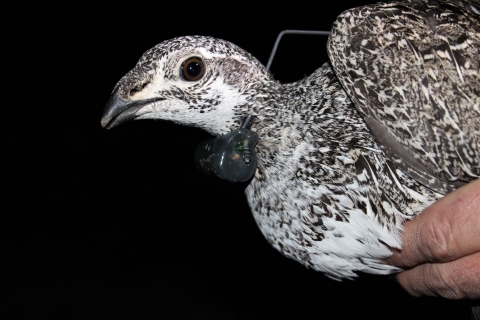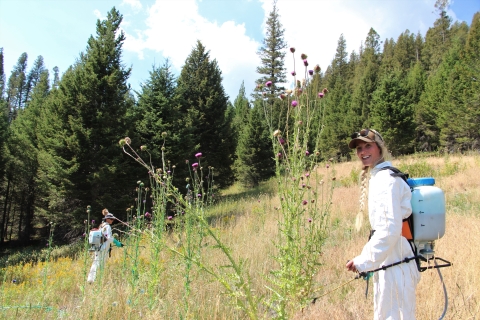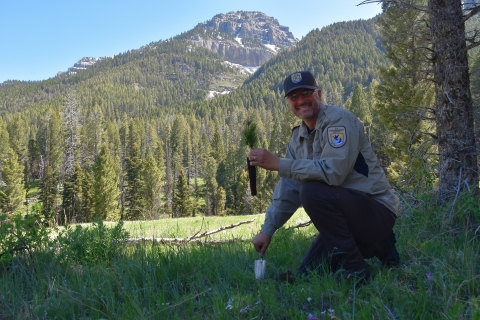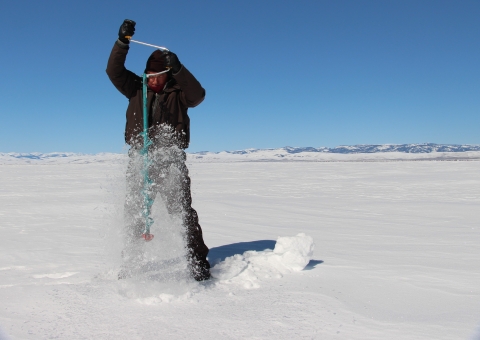What We Do
Red Rock Lakes National Wildlife Refuge is a conservation leader in the Centennial Valley working with others create and sustain native habitat for migratory fish and wildlife.
Management and Conservation
The ongoing conservation efforts at Red Rock Lakes National Wildlife Refuge aim to provide habitat for breeding and staging migratory birds, native fishes, and both resident and migratory wildlife that maintains the biological diversity and integrity of this montane wetland system.
Management Plan
The Comprehensive Conservation Plan sets the direction for management and use of the Refuge, and includes the following major actions:
- Maintain high productivity in wetlands to benefit nesting and migrating trumpeter swans and other waterfowl.
- Restore two modified wetlands (32 acres) back to a free-flowing, historical spawning stream for the lower 48 states’ last known population of adfluvial Arctic grayling fish. (Adfluvial: lake inhabitant that breeds in a river.)
- Increase opportunities for environmental education and interpretation to better orient visitors to the values of the Refuge and the Centennial Valley.
- Provide and expand opportunities for quality hunting and fishing experiences while ensuring that trumpeter swans and other priority migratory birds have protected resting areas.
Comprehensive Conservation Planning
The purpose of a CCP is to specify a management direction for the Refuge for the next 15 years. The goals, objectives, and strategies for improving Refuge conditions, including the types of habitat we will provide, partnership opportunities, and management actions needed to achieve desired conditions, are described in the CCP. The Service’s preferred alternative for managing the Refuge and its effects on the human environment, are described in the CCP as well.
The Refuge System is managed by the Fish and Wildlife Service (Service), an agency within the U.S. Department of the Interior. The Service is the primary Federal entity responsible for conserving and enhancing the Nation’s fish and wildlife populations and their habitats. Although the Service shares this responsibility with other Federal, State, tribal, local, and private entities, the Service has specific trust resource responsibilities for migratory birds, threatened and endangered species, certain anadromous fish, certain marine mammals, coral reef ecosystems, wetlands, and other special aquatic habitats. The Service also has similar trust responsibilities for the lands and waters it administers to support the conservation and enhancement of all fish and wildlife and their associated habitats.
Our Services
Be Prepared
Red Rock Lakes is a remote site that is at least 40 miles from the nearest gas station, store, or mechanic shop. The gravel roads can be rough on tires and vehicles can get stuck in snow or mud, so vehicles with 4-wheel drive and high clearance are recommended. Cell service is also limited for most carriers, so we encourage visitors to check in with someone they know or carry a satellite device for communication. Our facilities and staff are unable to provide maintenance, fuel, or repair services to the public, so we recommend arriving with a full fuel tank, a spare tire, patch kit, and an inflator.
Visitor Center
The visitor center is closed seasonally from November 1- April 30.
Wheelchair-accessible public restrooms and a bottle filling station are available to visitors during open hours. A vault toilet outside is available when the visitor center is closed. Picnic tables are set up during summer months, but there are no public waste disposal facilities and trash must be packed out.
Campgrounds
Red Rock Lakes operates two primitive campgrounds with sites available on a first come, first served basis.
- Campsite availability is on a first come first served basis only - reservations are not accepted.
- Camping is allowed only in the two established campgrounds – River Marsh Campground and Upper Lake Campground and is restricted to 16 consecutive days within any 30-day period.
- Dispersed or backcountry camping in Refuge wilderness areas, along roadsides, or areas outside of the established campgrounds is not permitted.
- Upper Lake Campground has potable spring water.
- Both campgrounds provide vault toilets. Please do not discard trash into the toilets.
- Fees for camping are: $7 per site per night; $5 per site per night with a Federal Interagency Annual, Senior, Access, or Volunteer pass; $4 for extra vehicle per site per night.
- Large campers and RVs are not recommended due to rough roads and jagged rocks in the roadbed causing flat tires.
- RVs and large camp trailers cannot be accommodated in the Upper Lake campground due to limited and confined space for vehicles to turn around.
- Larger vehicles are encouraged to utilize the River Marsh Campground at Lower Red Rock Lake.
- All bear attractants, including but not limited to food and garbage, must be stored acceptably in bear-proof storage at night (unless in immediate use) and during the day if unattended. Please use the bear storage boxes present in the campgrounds or store food in a locked vehicle.
- Leave no trace. Pack out all trash generated during your stay. There are no trash removal services at the Refuge.
Our Projects and Research
Wilderness Stewardship
A large part of Red Rock Lakes National Wildlife Refuge is designated wilderness. As we carry out our fieldwork, we consider the impacts of our activities and how we can preserve wilderness character. To access wilderness areas for fieldwork, we travel on foot, on skis, or in canoes and kayaks to preserve the values of the Refuge wilderness.
Ecological Restoration
The Refuge is a wild place in a remote location, but even here human activity impacts the landscape. Management of the Refuge includes removing the marks left by past generations and building ecosystem resilience.
Invasive Species ControlThe Centennial Valley is an especially remote place with fewer vectors for invasive species invasive species |
Grassland RestorationFive acres were restored in a field formerly inundated with invasive grasses at Red Rock Lakes National Wildlife Refuge. Eight species of native grasses and twelve species of native flowering forbs combining with some already present native forbs are expected to provide improved habitat for pollinators, birds, and mammals. In addition to returning this field to its fully functioning ecosystem state, it may also serve as an environmental education and interpretive site. |
Aspen ReforestationVolunteers, technicians, and Refuge staff planted over 2,000 aspen tree seedlings in two exclosures totaling nearly five acres in size at a Refuge timber improvement project site to facilitate Wildland Urban Interface and to accomplish the Refuge's aspen reforestation goal outlined in its Comprehensive Conservation Plan. The timber improvement project will help mitigate wildfire dangers near the Refuge headquarters. Aspen seeds were hand collected from different mother trees around the Refuge and atop Red Rock Pass, then propagated into seedlings by the Montana Dept. of Natural Resources and Conservation tree seedling nursery. Many thanks to all who volunteered their time and efforts on to plant tree seedlings at Red Rock Lakes National Wildlife Refuge. |
Whitebark PineThe range of the endangered whitebark pine (Pinus albicaulis) extends throughout the Greater Yellowstone Ecosystem, including the mountainous areas of Red Rock Lakes. We partnered with the Montana DNRC tree seedling nursery, by collecting cones filled with seed, which they propagated into seedlings for subsequent planting to help this important keystone species persevere. |
Monitoring and Management
PollinatorsThe state of Montana is home to over two dozen native bumblebee species, many of which make their home in the Centennial Valley. A few particularly interesting species have been documented on the Refuge, including the Western bumblebee (Bombus occidentalis) and Suckley's cuckoo bumblebee (B. suckleyi). We plan to continue monitoring for these species and others in partnership with The Xerces Society for Pollinator Conservation. |
Willow BrowseTechnicians identify different species of willows and perform browse surveys to assess the level of moose herbivory, its effect on overall willow community health, and subsequent ecosystem effects. Data collected will help assess browse pressure exhibited by moose. Willows provide important habitat for songbirds and winter food resources for several ungulate species, so understanding browse impact is important in determining willow community health. |
Carnivore InventoryThe Refuge has several carnivore species inhabiting its many different habitat types. We use non-invasive means to document these elusive creatures. |
Bluebird TrailThe Refuge bluebird trail is at over 90 nest boxes and 18+miles long. With invasive bird species like European starlings and English sparrows often outcompeting native bluebirds for natural nest sites, the Refuge’s bluebird trail takes on an increased importance. Volunteers and seasonals monitor nestling development and record survivorship, species composition, and timing of fledging each year. |
Arctic Grayling Adaptive Management Plan
Red Rock Lakes is home to a population of Arctic grayling (Thymallus arcticus) that have been experiencing a steep decline in recent years. The U.S. Fish & Wildlife Service has formed a partnership with Montana Fish Wildlife & Parks to monitor and manage the fish population and habitat in the lakes and streams throughout the Centennial Valley in SW Montana. Researchers and biologists from both organizations have worked together to try and determine the factors affecting the species' decline and to develop a plan of action to support these fish through habitat projects and partnerships with landowners.
Winter HypoxiaUpper Red Rock Lake, which only 6 feet at its deepest point, is important winter habitat for grayling. When the first few feet on the surface of the lake freeze, this leaves less available water from which the fish can extract oxygen, a condition called hypoxia. Hypoxic conditions are thought to be a contributing factor in the decline of the Arctic grayling population, so researchers measure ice depth and dissolved oxygen levels at different depths to determine the amount of suitable winter habitat available from year to year. |
Law Enforcement
U.S. Fish & Wildlife Law Enforcement officers work closely with surrounding Federal, State, and Local Law enforcement agencies to help facilitate all visitors' quality experience while on the Refuge.








